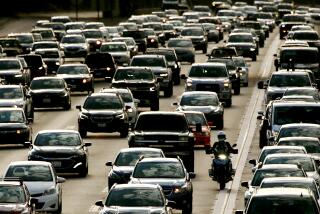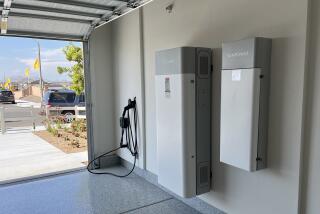Don’t Let Energy Policy Run Out of Steam : California leads and shouldn’t quit while ahead
A war at least partly over protecting oil in the Middle East held Americans spellbound for months, but the mere mention of a strategy to reduce American dependence on oil is still enough to produce political gridlock.
This is among the more troubling findings by Times writers in a recent series of reports on the nation’s energy picture in general and the prospects for relaxing oil’s grip on U.S. industry and society in general.
Happily, the California picture is quite different, partly because of the natural link between the state’s smog problems and energy efficiency.
SMART ENERGY: Californians still buy gas-guzzlers and drive them more miles than ever, but the state is also leading the way into smart energy policy. The picture is impressive enough that California must take care not to quit while it’s ahead.
California, for example, uses less energy per capita now than it did in the mid-1970s, while the rest of the country uses more. Part of this is because the population grew faster than the state could build energy installations, but it owes much also to the California Energy Commission, which fought hard for strict energy efficiency standards for buildings and appliances years ago.
California also is far ahead in generating electricity with renewable energy technologies that include solar, wind turbine, geothermal and biomass. One biomass furnace in the San Joaquin Valley generates enough power to supply 30,000 households burning agricultural trash--prunings, fruit pits and waste wood.
The goal of Northern California’s biggest utility, Pacific Gas & Electric Co., is to meet 75% of new energy demand over the next 10 years with supplies saved under conservation programs. But that still means increasing the supply by 25%, and California must keep working to expand the share of that which can come from renewable resources--so called to distinguish them from depletable fuels like petroleum and coal. They now account for nearly 10% of California power.
TAX INCENTIVES: But as Times writer Patrick Lee noted, building fields of solar reflectors and covering hillsides with windmills has required tax incentives. While competition from other energy sources is headed up, the tax breaks are headed down.
A California property tax exemption for solar energy installations, for example, expired in January and no more solar generating capacity is being built. A bill by state Sen. Becky Morgan (R-Los Altos Hills) would restore the tax exemption through 1994 and should be approved. This is one way for California to avoid quitting while it is ahead.
THE CAR: California also has jump-started production of the first commercial electric cars in decades with moves primarily intended to clean up Southern California’s air.
Under a state Air Resources Board order, a percentage of all new cars sold in California later this decade must be pollution-free. Among the available technologies, only an electric car could qualify.
In addition, the Los Angeles Department of Water and Power has struck a bargain with Southern California Edison to underwrite building 10,000 electric cars and guarantee a market for them starting in 1995.
Sacramento must try again to impose a surtax on gas-guzzling cars and use the money it collects to give rebates to buyers who settle for more fuel-efficient cars. Such a bill passed last year, but was vetoed.
Legislation is moving through Congress to require cars to get 40% more miles to the gallon by the turn of the century. With gasoline prices sinking and the Persian Gulf War over, the bill might stall. If so, California should insist--as Gov. Pete Wilson says he will--that Congress at least let California set its own high standards.
California is clearly headed in the right direction. It should keep leading the way.
More to Read
Sign up for Essential California
The most important California stories and recommendations in your inbox every morning.
You may occasionally receive promotional content from the Los Angeles Times.









